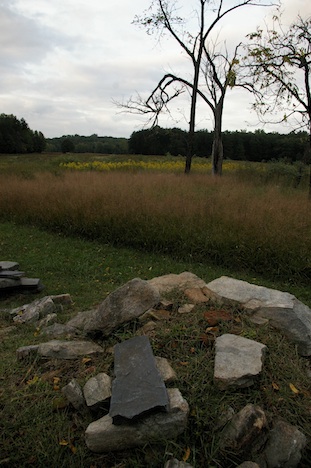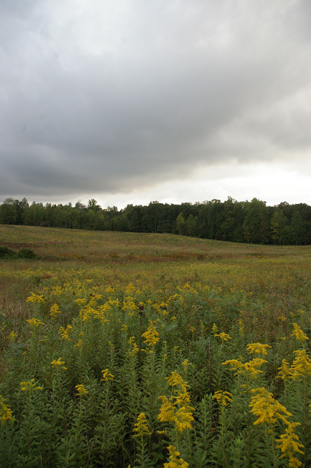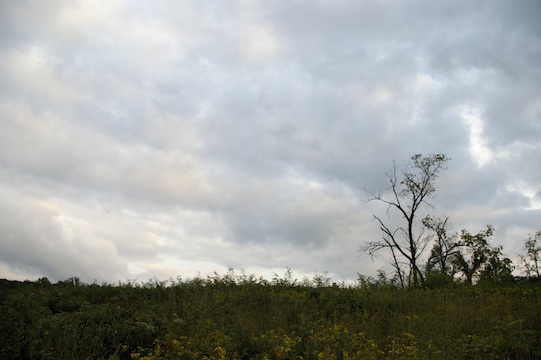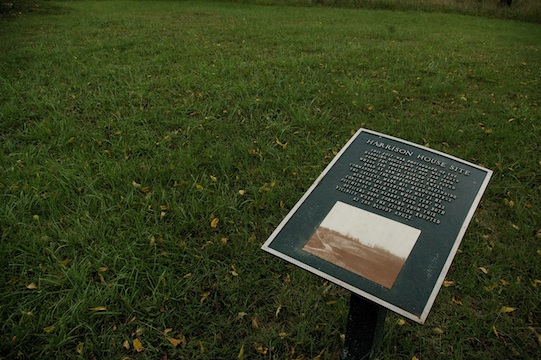Engineering Over Infantry: Spotsylvania, May 18, 1864
We cross the last hundred yards of open field—from the paved park road that runs parallel to “Lee’s Second Line” toward the Harrison House—that the Union soldiers could not cross. Our path runs through patches of grasses, ferns, and scrub watercolored with the first brushes of emerging fall color. We pass over the trickle of a stream before hiking up the final rise to the house site itself. No Union soldier made it this far, even with the protection offered by the hill.
Caity and I have come to Spotsylvania, to what had once been the interior of the Mule Shoe Salient, to find one of the battlefield’s forgotten stories. The Federal assaults on May 18, 1864 stand as a testament to the power of engineering over infantry in one of the most futile efforts of Grant’s entire Overland Campaign.
But to look at the field today, there’s nary an indication that anything happened here at all.
 The park’s emphasis in recent years on slave and civilian stories has left much of the battlefields’ military history untold and unexplored. The Federal assault on May 18 deserves attention because it was just as large as the Federal assault against the Mule Shoe on May 12. It covered the same ground and used the same tactics, and it pitted many of the same Federals against the same Confederates.
The park’s emphasis in recent years on slave and civilian stories has left much of the battlefields’ military history untold and unexplored. The Federal assault on May 18 deserves attention because it was just as large as the Federal assault against the Mule Shoe on May 12. It covered the same ground and used the same tactics, and it pitted many of the same Federals against the same Confederates.
Yet the outcome could not have been more different.
Ewell’s veterans, so bruised on May 12, had spent the intervening six days doing nothing but resting and fortifying. The works they created were the strongest field fortifications seen in the east to date.
The remnants of those works still wind along the crest of the hill through the woods along the Spotsylvania history trail. They are among the best-preserved earthworks in the park accessible to visitors.
In front of the works, Confederates had spread “acres of abatis” and a picket line. “As the Confederate skirmishers were swept back before the strong lines of blue,” wrote one Massachusetts soldier, “the restrained tempest broke forth, and with shriek and scream and hissing, poured its death blast in the faces of the Union soldiers.”
The Confederate artillery “mowed the men down in rows,” wrote a Rhode Islander. One Confederate called it “terrible execution.”
The smoke and cacophony of battle—so different than this quiet overcast evening Caity and I walk the ground—“filled the valleys, and rested on the hills of all this wilderness, hung in lurid haze all around the horizon, and built a dense canopy overhead,” wrote a Union medical officer.
 “For a few minutes all was observed in mystery,” said Major Wesley Brainerd of the 50th NY Engineers. “Moments seemed like hours. Then the cheering ceased and dark masses of our men were seen through the openings in the uprising smoke returning as they went but with awfully suggestive gaps in their ranks. The assault had failed. Soon the smoke cleared away and disclosed the ground for long distances thickly strewn with our dead and dying men. It was an awfully grand spectacle, one often repeated around that ground which has been justly styled ‘Bloody Spotsylvania.’”
“For a few minutes all was observed in mystery,” said Major Wesley Brainerd of the 50th NY Engineers. “Moments seemed like hours. Then the cheering ceased and dark masses of our men were seen through the openings in the uprising smoke returning as they went but with awfully suggestive gaps in their ranks. The assault had failed. Soon the smoke cleared away and disclosed the ground for long distances thickly strewn with our dead and dying men. It was an awfully grand spectacle, one often repeated around that ground which has been justly styled ‘Bloody Spotsylvania.’”
Federal casualties on the field totaled some 1,250 men. Most of them were “torn all to pieces with canon balls,” said one Confederate observer. A Richmond newspaper explained that “[v]ery little musketry was used in this engagement, for the reason that the enemy did not come near enough our lines.”
I stand at the crest of the hill and look back across the assault field and really think about that: Confederate artillery laid down such devastating fire that Confederate infantry hardly had to engage. What must it have been like out there on that field, all patchwork color this evening but all blue and blood and smokey gray on that May morning years ago?
No traces of the carnage remain on the field, of course—but no traces remain in the public imagination or memory, either. The only interpretive marker on this part of the battlefield sits on a small plot of grass near the ruins of the Harrison House, where Lee and Ewell made their headquarters before the May 12 assault. The sign, which is decades old, explains the site’s significance to that incident, but it remains mute on the May 18 attack. It remains mute on the Harrison family, too.
Beyond the Bloody Angle, Spotsylvania illustrates the ongoing chess match between Grant and Lee as they poke and probe and maneuver and fight. The details of that strategic struggle largely get ignored—although that very strategy allows Grant to eventually win the war.
The stories go untold. The voices go unheard. The landscape goes uninterpreted.
Caity takes pictures. I write words. We try to see this land, share this story, so people won’t forget.
———————–
For further reading on the May 18 assaults, check out the article Kris White and I wrote for Blue & Gray magazine (XXVII #6, 2011). You can also always count on Gordon Rhea— look to chapter five in To the North Anna River for his extensive account.



Spotsylvania is really a gem of a battlefield. It is peaceful and well preserved, yet it is overlooked by almost everyone. History wise, it could be that it is lumped in historically with the Overland Campaign. Location wise it is just far enough in the “country” and away from Fredericksburg that visitors don’t travel there as much. When doing any type of programs at FRSP the ones closer to Fredericksburg always saw vastly more people. Farther from the city the less visitors and locals traveled. Either way there needs to be improved interpretation for those who visit the battlefield, regardless of the economic climate. Which leads to another point…
You bring up a great point with interpretation of a battlefield. For decades it was farmland and for two weeks it was battlefield. So what event defines the land the decades or the weeks? Then you must find what balance to strike between the battle and civilian’s that lived there. Should it be 50-50, 60-40, etc…. in presenting the story?
Great questions, Kris. I’d be curious to see what other readers think.
For my own part, it’s obvious to me that we set aside an area like that for preservation because soldiers fought a battle there. Otherwise, we could set aside any and all locations because once upon a time someone lived there, someone farmed there, someone worked there, etc. The land has been preserved because someone fought there, because someone died there. That’s what made it different than all the other places and worthy of attention.
The battles give us the opportunities to tell other stories, but it’s important to remember which story has primacy from a preservation/interpretation point of view. We should still acknowledge the other histories the land has, and even use the battle to put those histories into context (and then even use those histories to put the battle into context)—but without the battles themselves, our eyes wouldn’t be focused on that land in the first place.
Kris,Spotsylvania is a beautiful area.Perhaps to pristine and peaceful.I find it hard to understand what the area must have been like during and afer the battle.I also find it hard to understand to huge scope of the battlelines.My great grand Father was wounded at the Bloody Angle(13thVirginia)and present at the “Lee to the rear episode” ( he was interviewed by the Fredricksburg newspaper about this around 1906) Perhaps the NPS could recreate small parts of the battlefield so it looks like he saw it in 1964.That would help the public better understand the horrow of the battle and what these men went through !( excuse spelling ,no spel check)
Berry
The park did try to recreate the trench works in two small places. The one line is falling apart and is not well maintained just behind the Bloody Angle). The other line is on Anderson Drive. It’s a great recreation of about 15 feet of works. There are miles of trenches and no way to recreate large portions of them, plus there is the argument about walking on or even touching the works themselves, so that opens up a another door of debate. Since this is something tangible the soldiers left many want to keep the trenches they way they are for posterity. Most of the visitors that do come to Spotsy come to walk, bike, etc… Few are there for the battlefield itself. Those I would speak to on a daily basis there were more worried about having benches to sit on, or stretch on after a run, then why they actually have green space to use in the first place.
Petersburg has a recreation of works a little ways down the road from the visitor center. I think they made a great attempt to bring the visitor the reality of the fortifications. Pamplin Park also has a great recreation of the Petersburg fortifications.
I’m glad you were able to make it down to Spotsy. It’s always nice to be able to walk in the footsteps of your ancestors. Was he captured after his wounding?
No ,he was later captured during/after Cedar Creek ,ended the war at Point Lookout ,was exchanged in feb 1865.
Plan to get to Fredricksburg in Oct,doing battlefield s and old houses.Iread the your new book on Chancellorsville and plan to use it for a tour .My favorite large battlefield,really like smaller ones better(Avensboro,Five Forks,New Market) because easier to follow .
Berry.
Glad you liked the new book, Berry. It was a great project to pull together. Please let me know how it works for you when you hit the field.
My 2nd great grandfather (116th Pennsylvania) was wounded in the field between the McCoull and Harrison houses. He did survive the war, and died in 1899. Last summer I was able to visit the battlefield, and walk that same field. It was a very moving experience. Your blog helped me imagine what that battle was like. Thank you.